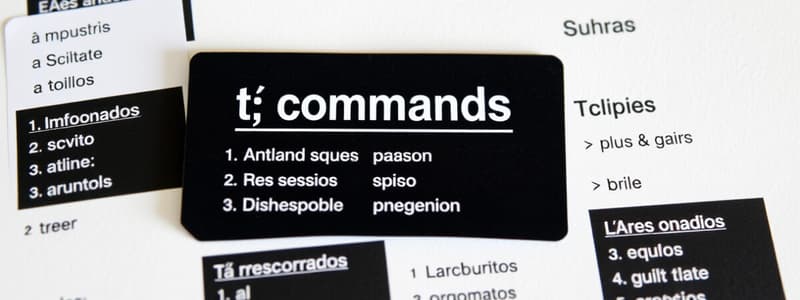Podcast
Questions and Answers
What are imperative affirmative informal commands (tú commands) used for?
What are imperative affirmative informal commands (tú commands) used for?
- To tell someone not to do something
- To tell someone to do something (correct)
- To suggest an action
- To ask for permission
What are imperative negative informal commands (negative tú commands) used for?
What are imperative negative informal commands (negative tú commands) used for?
- To tell someone to do something
- To tell someone not to do something (correct)
- To ask for help
- To suggest an action
How do you conjugate affirmative tú commands?
How do you conjugate affirmative tú commands?
Conjugate the verb normally in the tú form, but remove the 's'.
What is the affirmative tú command for 'bailar'?
What is the affirmative tú command for 'bailar'?
What is the affirmative tú command for 'comer'?
What is the affirmative tú command for 'comer'?
What is the affirmative tú command for 'oír'?
What is the affirmative tú command for 'oír'?
How do you conjugate negative tú commands?
How do you conjugate negative tú commands?
What is the negative tú command for 'caminar'?
What is the negative tú command for 'caminar'?
What is the negative tú command for 'leer'?
What is the negative tú command for 'leer'?
What is the negative tú command for 'escribir'?
What is the negative tú command for 'escribir'?
Name an irregular affirmative tú command.
Name an irregular affirmative tú command.
What is the affirmative tú command for 'tener'?
What is the affirmative tú command for 'tener'?
What is the negative tú command for 'venir'?
What is the negative tú command for 'venir'?
What is the negative tú command for 'decir'?
What is the negative tú command for 'decir'?
What is the affirmative tú command for 'ir'?
What is the affirmative tú command for 'ir'?
How many verbs have irregular affirmative tú commands?
How many verbs have irregular affirmative tú commands?
How many verbs have irregular negative tú command endings?
How many verbs have irregular negative tú command endings?
Flashcards are hidden until you start studying
Study Notes
Imperative Informal Tú Commands
- Imperative commands are used to instruct someone informally to perform an action.
- There are two types: affirmative (to do something) and negative (to not do something).
Affirmative Informal Commands (Tú)
- Formed by conjugating the verb in the tú form and dropping the "s".
- Similar to the present tense conjugation of él/ella/usted.
- Examples include:
- bailar → baila
- comer → come
- oír → oye
Negative Informal Commands (Tú)
- Formed by conjugating the verb in the tú form, altering endings based on the verb type (-as to -es for -ar verbs, -es to -as for -er/-ir verbs).
- Always place "no" before the command.
- Examples include:
- caminar → no camines
- leer → no leas
- escribir → no escribas
Irregular Affirmative Tú Commands
- Eight verbs have unique affirmative tú forms:
- ser → sé
- poner → pon
- tener → ten
- salir → sal
- venir → ven
- ir → ve
- decir → di
- hacer → haz
Irregular Negative Tú Commands
- Eleven verbs have specific forms in negative commands:
- tener → no tengas
- venir → no vengas
- decir → no digas
- salir → no salgas
- hacer → no hagas
- poner → no pongas
- ser → no seas
- ir → no vayas
- dar → no des
- estar → no estés
- saber → no sepas
Additional Tips for Other Verbs
- Other verbs may also have irregular negative forms, requiring close attention.
- Examples of additional commands include:
- tocar → no toques
- buscar → no busques
- sacar → no saques
- entregar → no entregues
- jugar → no juegues
- llegar → no llegues
- comenzar → no comiences
- empezar → no empieces
- almorzar → no almuerces
Studying That Suits You
Use AI to generate personalized quizzes and flashcards to suit your learning preferences.




